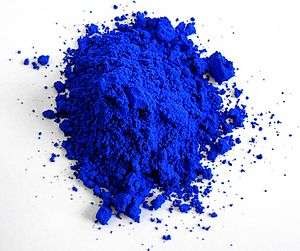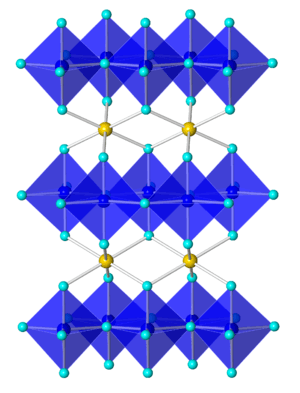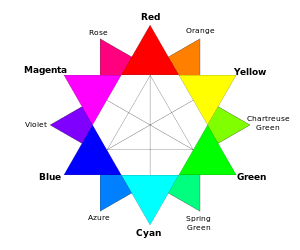YInMn Blue
YInMn Blue (for yttrium, indium, manganese), also known as Oregon Blue, Mas Blue, or Yin Min Blue, is an inorganic blue pigment that was discovered accidentally by Professor Mas Subramanian and his then-graduate student Andrew E. Smith at Oregon State University in 2009.[2][3] It is the first inorganic blue pigment discovered in 200 years, since cobalt blue was identified in 1802.[3][4]
| YInMn Blue | |
|---|---|
 YInMn Blue powdered pigment | |
| Hex triplet | #2E5090 |
| sRGBB (r, g, b) | (45.82, 79.92, 143.51) |
| CMYKH (c, m, y, k) | (68.07, 44.31, 0, 43.72) |
| HSV (h, s, v) | (219.06°, 68.07%, 56.28%) |
| Source | [1][lower-alpha 1] |
| ISCC–NBS descriptor | Deep blue |
| B: Normalized to [0–255] (byte) H: Normalized to [0–100] (hundred) | |
 Crystal structure of YInMn Blue | |
| Identification | |
|---|---|
| Formula | YIn 1−xMn xO 3 |
| Crystal system | Hexagonal |
| Crystal symmetry | P63cm |
| Unit cell | a = 6.24 Å; c = 12.05 Å |
| Color | Light to dark blue |
The compound has a unique trigonal bipyramidal structure, and further research has discovered it may be modified to create green, purple, and orange pigments.[5]
Discovery
In 2008, Subramanian received a National Science Foundation grant to explore novel materials for electronics applications. Under this project, he was particularly interested in synthesizing multiferroics based on manganese oxides. He directed Andrew E. Smith, a graduate student in his lab, to synthesize an oxide solid solution between YInO
3 (a ferroelectric material) and YMnO
3 (an antiferromagnetic material) at 1,093 °C (2,000 °F). The resulting compound was not an effective multiferroic; instead, it was a vibrant blue material. Because of Subramanian's experience at DuPont, he recognized the compound's potential use as a blue pigment and filed a patent disclosure covering the invention. After publishing their results, Shepherd Color Company successfully contacted Subramanian for possible collaboration in commercialization efforts.[6][7]
The pigment is noteworthy for its vibrant, near-perfect blue color and unusually high NIR reflectance.[2][1] The color may be adjusted by varying the In/Mn ratio in the pigment's base formula of YIn
1−xMn
xO
3, but the bluest pigment, YIn
0.8Mn
0.2O
3, has a color comparable to standard cobalt blue CoAl
2O
4 pigments.[1]
Properties and preparation
YInMn Blue is chemically stable, does not fade, and is non-toxic. It is more durable than alternative blue pigments such as ultramarine or Prussian blue, retaining its vibrant color in oil and water, and is safer than cobalt blue, which is a suspected carcinogen and may cause cobalt poisoning. Moreover, infrared radiation is strongly reflected by YInMn Blue, which makes this pigment suitable for energy-saving cool coatings.[8] It can be prepared by heating the oxides of the elements yttrium, indium, and manganese to a temperature of approximately 1,200 °C (2,200 °F).[9]
Commercialization and popular culture
After Subramanian and his colleagues published their results, companies began inquiring about commercial uses. Shepherd Color Company eventually won the license to commercialize the pigment in May 2015.[4][8][10][11]
In June 2016, an Australian company, Derivan, published experiments using YInMn within their artist range (Matisse acrylics),[12] and subsequently released the pigment for purchase.[4]
AMD announced in July 2016 that the pigment would be used on new Radeon Pro WX and Pro SSG professional GPUs for the energy efficiency that stems from its near-infrared reflecting property.[13][14]
The American art supplies company Crayola announced in May 2017 that it planned to replace its retired Dandelion color (a yellow) with a new color "inspired by" YInMn, but not containing any YInMn.[4] Crayola held a contest for more pronounceable name ideas, and announced the new color name, "Bluetiful", on 14 September 2017.[15][16][17] The new crayon color has been available since late 2017.
Notes
- The color coordinates were obtained from Smith et al. 2016 for the optimal blue pigment, which has the composition YIn
0.8Mn
0.2O
3. The CIELAB coordinates (L = 34.6, a = 9.6, b = −38.9 in table 1) were converted using an online tool.
References
- Smith, Andrew E.; et al. (October 2016). "Spectral properties of the UV absorbing and near-IR reflecting blue pigment, YIn
1−xMn
xO
3". Dyes and Pigments. 133: 214–221. doi:10.1016/j.dyepig.2016.05.029. - Smith, Andrew E.; et al. (2 December 2009). "Mn3+ in Trigonal Bipyramidal Coordination: A New Blue Chromophore". Journal of the American Chemical Society. 131 (47): 17084–17086. doi:10.1021/ja9080666. ISSN 0002-7863. PMID 19899792.
- Rosenberg, Gabriel (16 July 2016). "A Chemist Accidentally Creates A New Blue. Then What?". NPR. Archived from the original on 23 May 2017.
- Cascone, Sarah (19 June 2017). "The Wild Blue Yonder: How the Accidental Discovery of an Eye-Popping New Color Changed a Chemist's Life". Artnet. Retrieved 15 May 2019.
- Li, Jun; et al. (13 September 2016). "From Serendipity to Rational Design: Tuning the Blue Trigonal Bipyramidal Mn3+ Chromophore to Violet and Purple through Application of Chemical Pressure". Inorganic Chemistry. 55 (19): 9798–9804. doi:10.1021/acs.inorgchem.6b01639.
- "The Story of YInMn Blue". Oregon State University. Retrieved 28 May 2018.
- "Licensing agreement reached on brilliant new blue pigment discovered by happy accident". Oregon State University. 27 May 2015. Archived from the original on 3 July 2016. Retrieved 2 July 2016.
- Schonbrun, Zach (18 April 2018). "The Quest for the Next Billion-Dollar Color". Bloomberg. Retrieved 20 April 2018.
- "YInMn blue". ColourLex. Archived from the original on 5 November 2017.
- "The Story of YInMn Blue". Oregon State University. Retrieved 28 May 2018.
- "Licensing agreement reached on brilliant new blue pigment discovered by happy accident". Oregon State University. 27 May 2015. Archived from the original on 3 July 2016. Retrieved 2 July 2016.
- "Product Profile: Yin Min Blue". YouTube. Derivan. 12 July 2016. Archived from the original on 5 November 2017.
- Carbotte, Kevin (25 July 2016). "Team Red Goes Blue: AMD Announces Radeon Pro WX Series". Tom's Hardware. Retrieved 15 May 2019.
- "Radeon Pro WX Series and YInMn Blue". YouTube. AMD. 15 August 2016. Archived from the original on 11 June 2017. Retrieved 22 August 2016.
- Bowerman, Mary (5 May 2017). "Crayola's newest crayon color is a shade of blue that was just discovered". USA Today. Archived from the original on 6 May 2017. Retrieved 5 May 2017.
- Waugh, Rob (16 May 2017). "Chemist finds new shade of blue by mistake (and Crayola is now making a crayon of it)". Metro. Archived from the original on 17 May 2017.
- "Crayola names new blue crayon 'Bluetiful' after retiring yellow 'Dandelion'". ABC News. 14 September 2017. Archived from the original on 14 September 2017.
External links
- United States patent 8282728: "Materials with trigonal bipyramidal coordination and methods of making the same"
